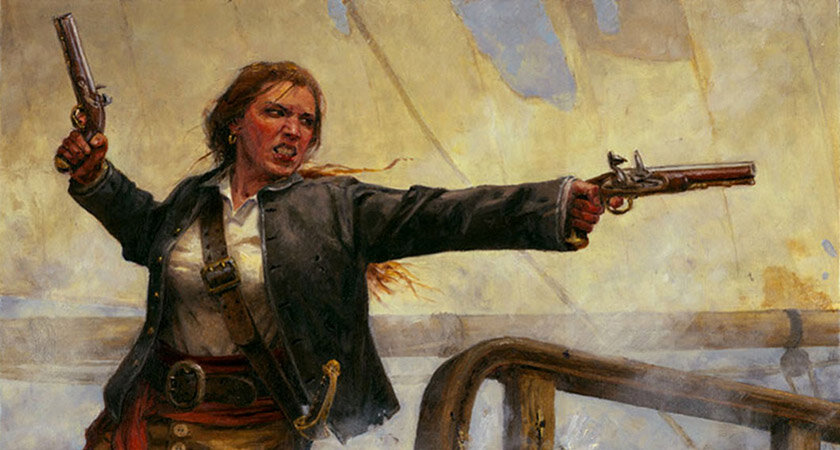7 inspiring women from Irish history you should know about
FROM warrior queens to political revolutionaries, the annals of Irish history have no shortage of formidable foremothers to shout about.
With that in mind, we've put together a list of some of the greatest female figures ever to have lived between these shores.
Here are 7 awe-inspiring women from Ireland's past that you should know about...
1. MAEVE OF CONNACHT
According to legend, in pre-christian times Queen Maeve led the warriors of Connacht against the Men of Ulster to claim the most famous bull in Ireland.
Her husband Ailill mac Máta had previously owned the greatest bull in the land, but upon hearing of a superior beast to the north, Maeve successfully captured it after a bloody battle.
Ailill must not have been the jealous type, as Maeve was notorious for her numerous lovers.
Maeve of Connacht didn't take no bull (Please forgive the awful, yet necessary pun)
2. GRACE O'MALLEY
No list of formidable Irish women would be complete without tomboy icon Gráinne Ní Mháille, the notorious 'Pirate Queen' of western Ireland.
Born on Clare Island, Co. Mayo in 1530, Grace famously cut off her hair after her father refused to take her on a voyage in case her locks got caught in the ropes.
In her prime, O'Malley commanded 3 galleys, 20 ships and over 200 men against her perpetual nemesis – the English – and even met with Elizabeth I before living to the ripe old age of 73. Not bad.
Grace O'Malley was the most feared pirate in the northwest Atlantic during her prime (Picture: History.com)
3. DR JAMES BARRY (MARGARET ANN BULKLEY)
Margaret Ann Bulkley was an Irishwoman who lived as a man during the Victorian era in order to be accepted first as a university student, and later, as a renowned military surgeon.
Going by the name Dr James Barry, Bulkley was born in Cork in 1795 and graduated from the University of Edinburgh Medical School in 1812 before becoming a surgeon in London.
Before retiring, Bulkley had become a sworn enemy of Florence Nightingale, risen to the second highest medical office in the British Army and improved conditions not only for wounded soldiers, but also for native inhabitants – performing the first successful cesarean section in Africa.
Dr James Barry (left) kept the secret of her true gender to her grave (Picture: Wikimedia)
4. CATHERINE HAYES
Born in Limerick in 1818, Catherine Hayes became arguably the world's most famous opera star during the 19th century, and the first ever opera singer to tour Australia.
According to London's Daily Express newspaper, "Hayes was the 'Madonna' of her day; she was the 19th-century operatic equivalent of the world's most famous pop star".
Hayes, a renowned diva, passed away in 1861 aged just 43 and left behind a will of £16,000 – equivalent to around £1 million in today's money.
Catherine Hayes was the most famous opera singer of her time (Picture: Wikimedia)
5. KATHARINE TYNAN
Born in Dublin in 1859, this daughter of a cattle farmer began writing poetry on her father's farm as a teenager.
Tynan went on to become an extraordinarily prolific writer and poet, penning 105 popular novels and countless newspaper articles – and was said to be able to write one novel per month in her prime.
A close friend of W.B. Yeats, by the time of her death in 1931, Tynan had also authored two anthologies, 16 poetry collections, 5 plays, 7 devotional books, one book about her dogs and 12 short story collections as well.
Katharine Tynan was the most prolific Irish writer of all time (Picture: Wikimedia)
6. ANNIE MOORE
Cork native Annie Moore became the first immigrant to be processed through the newly-opened Ellis Island in New York on January 1, 1892.
Aged just 17 at the time, Annie looked after her brothers Phillip (7) and Anthony (11) on the ship over, before going on to have 11 children of her own with German Catholic salesman Joseph Augustus Schayer.
Moore died in 1924. Her previously unmarked grave was identified over eight decades later in 2006, and a Celtic Cross made from Irish Blue Limestone was later unveiled at her final resting place.
Annie Moore was the first immigrant to pass through Ellis Island in 1892 (Picture: AnnieMoore.net)
7. CONSTANCE MARKIEVICZ
Constance Markievicz became the first-ever female MP elected to the House of Commons in 1918, just two years after she took up arms against the British in the 1916 Rising in Dublin.
The Countess was a staunch Irish Republican throughout her life, and refused to take her seat in Parliament on account of Sinn Féin's absenstionist policy, which endures to this day.
Constance became a senior minister in the Dáil after Ireland became independent in 1922, but died a pauper's death five years later after giving up the last of her wealth to be "among the poor where she wanted to be."







